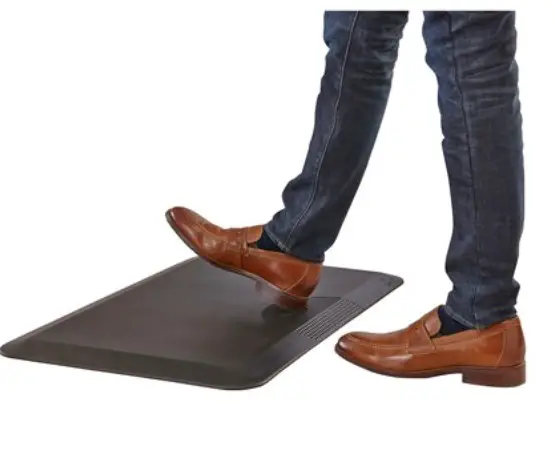Whether you’re buying or considering an anti-fatigue mat, you probably have some questions about them. There are some key anti-fatigue mat FAQs that you should know about. These could prevent you from damaging the mat, purchasing the wrong one and even using it the wrong way! This article helps you decide if anti-fatigue mats are a good option for you… And more! So, stay tuned!
If you’re in a hurry, here is a site I recommended for office equipment with lifetime guarantee!
Fatigue-reducing mats can increase your productivity and reduce downtime as you work. Source

Anti-fatigue Mat FAQs
1. How long do anti-fatigue mats last?
An anti-fatigue mat can be expected to last on average 1 – 3 years. However, the greater the use and pressure the mat gets, the more likely it is to wear faster. Additionally, if a standing mat is used in an environment that it is not designed for, e.g., around chemicals, it could be come damaged or worn faster. If the anti-fatigue mat is not properly installed or used correctly, it can also lead to greater depreciation. Ultimately, the anti-fatigue mat should be replaced when signs of wear and tear are observed.
Opting for a heavy-duty anti-fatigue mat will mean that the mat can tolerate greater use throughout the day (> 6 hours per day).
Compare this to a light-duty anti-fatigue mat which is designed for use <4 hours per day.
There are also medium-duty anti-fatigue mats which are designed to be used between 4 – 6 hours a day.
Factors which can affect damage to the mat include:
- Whether they are used properly
- How often they are use
- If the correct footwear is worn
- If objects are placed or rolled over the mat
- The type of standing mat durability selected
You can find this Safco Movable Anti-Fatigue Mat with a lifetime warranty on OfficeFurniture2Go.com.
Tip: GelPro anti-fatigue mats have warranties from 2 – 10 years in length.
2. Can anti-fatigue mats be trimmed?
Some anti-fatigue mats, usually industrial anti-fatigue mat tiles, can be cut using a utility knife. However, standard anti-fatigue mats are often not suited to being cut due to their thickness and the material layers inside them.
While some mats are made from gel, it is in a solid state and unlikely to leak out. But there is a risk that the mat could separate or delaminate.
Cutting the fatigue-reducing mat can detract from the appearance and can even void the warranty.
Plus, it helps to maintain an anti-fatigue mat if you don’t cut or interfere with it.
It is neater and safer to get custom-cut anti-fatigue mats made.
Ultimately, the manufacturer should be contacted to confirm if the standing mat is suitable for being cut or not.
3. How thick should an anti-fatigue mat be?
The recommended thickness of a standing mat is usually between 0.75 – 1 inch thick. The minimum thickness of a good anti-fatigue mat should be at least 0.375 inches thick.
This should allow you to stand with comfort for at least 60 – 90 minutes.
Anti-fatigue mats come in a range of thickness levels, beginning at 0.375 inches and ranging as thick as 1.25 inches +.
However, choosing too thick of a standing mat could result in a lack of support for your body. Your best bet is to stick to between 0.375 – 1 inch in thickness, unless you’re told otherwise.
4. Should you wear shoes with anti-fatigue mat?
Whether you wear shoes or not on an anti-fatigue mat is generally down to personal preference and the requirements of the area. There isn’t an agreed consensus on whether being barefoot or wearing shoes on fatigue-reducing mats is better.
That said, footwear that inhibits your movement should be avoided.
The best shoes to wear include flat shoes, such as tennis shoes, runners, ballet flats or flip flops.
The types of shoes that should not be worn while standing on an anti-fatigue mat include high heels and shoes with rugged or sharp soles.
Yes, stilettos, I’m talking about you!
Tip: Being barefoot can cause less wear and tear to the standing mat than wearing shoes.
5. Can anti-fatigue mats be painted?
Most anti-fatigue mats can be painted provided you use the correct type of paint that is compatible with the mat material. That said, most manufacturers will advise against painting an anti-fatigue mat. In fact, some companies state that if you paint your anti-fatigue mat, it voids the warranty.
I have seen scenarios where people have painted their worn anti-fatigue mats with acrylic craft paint as the print had faced. Then then repurposed the standing mat as a standard mat.
In such instances, you probably won’t care about warranties. In fact, you’ll probably have surpassed your warranty by that stage anyway.
Related: Balance boards vs anti-fatigue mat – cheat sheet included
6. Are anti-fatigue mats toxic?
Anti-fatigue mats generally don’t contain toxic materials. But that’s not something that you can take as a given for every mat.
To verify if a standing mat has toxic materials, look for a mat that is labelled non-toxic and is free of the following materials:
- Phthalate
- Volatile oil compounds (VOCs)
- Polycyclic aromatic hydrocarbons (PAHs)
- Formamide
- Fire-retardants
- PVC
- BPA
- PBS
- Formaldehyde
- Lead
Tip: Some mats are also Prop 65 compliant.
7. How do you wash anti-fatigue mats?
To properly clean anti-fatigue mats and their surrounding area, they need to be fully lifted up. Then the floor and all sides of the mat should be cleaned using a cloth, mild soap and water.
For industrial anti-fatigue mats, you may need a light brush to clean in between the crevices.
Generally, anti-fatigue mats are not machine washable.
Finally, the mat will need to be dried before returning it to the area.
Tip: Proper care and cleaning can make a standing mat last even longer!
Conclusion
As you can see, there are an endless list of things to be aware of whether you’re in the process of purchasing a standing mat or you already own one.
The above standing mat FAQs only scratch the surface of essential factors that you should know about anti-fatigue mats.
If you’re interested in more, here are some other useful articles I wrote that you should go check out:
- How do anti-fatigue mats work? With FAQs & Helpful Tips!
- How to choose an anti-fatigue mat – 16 essential factors
- How to maintain anti-fatigue mats – 12 easy tips
- How Much Do Anti-fatigue Mats Cost? – A Complete Guide!
- Are Anti Fatigue Mats Worth It? 11 Unexpected Pros & Cons!
Recommended products:
